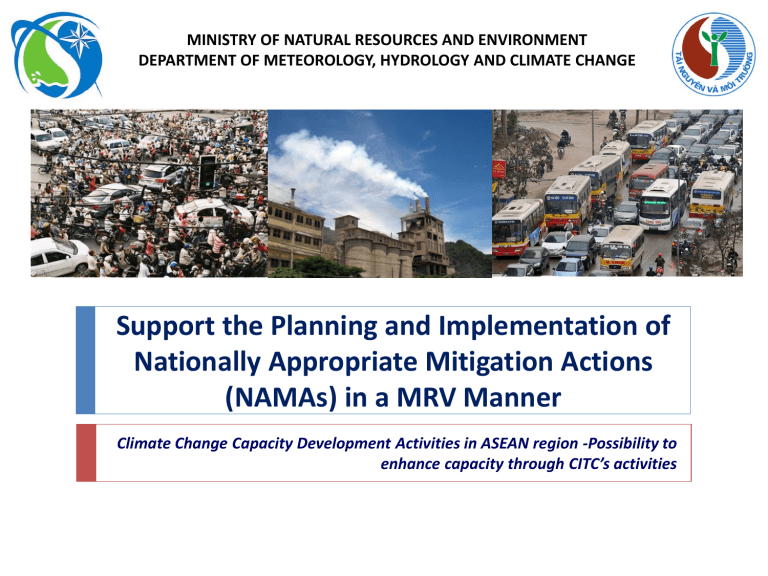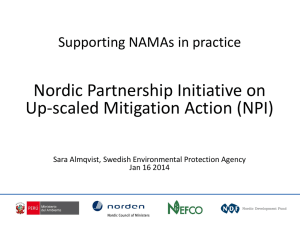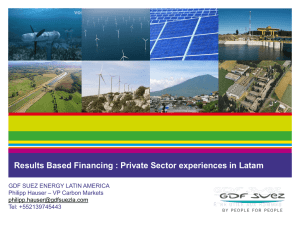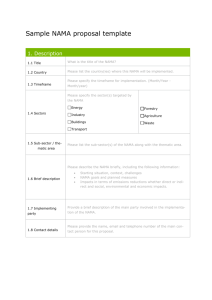VIETNAM MINISTRY OF NATURAL RESOURCES AND

MINISTRY OF NATURAL RESOURCES AND ENVIRONMENT
DEPARTMENT OF METEOROLOGY, HYDROLOGY AND CLIMATE CHANGE
Support the Planning and Implementation of
Nationally Appropriate Mitigation Actions
(NAMAs) in a MRV Manner
Climate Change Capacity Development Activities in ASEAN region -Possibility to enhance capacity through CITC’s activities
Content
The urgency of developing and implementing NAMA
Legal foundation to support NAMA development
Current understanding and capacity on NAMA
NAMA and relevant MONRE agencies
Priority areas of works
The Project “SPI-NAMA”
The urgency of developing and implementing NAMA
Vietnam has experienced very high growth rates in the past decades
Lately, growth has been less impressive
GDP Growth Rates (annual %)
The urgency of developing and implementing NAMA
Evolution of Vietnam’s CO
2
Emissions/GDP Relative to Other Countries
One of the fastest growth of GHG emission in the region
Carbon intensity of GDP increased more than that of regional average
The urgency of developing and implementing NAMA
GHG Emission Scenarios for Viet Nam's Energy Sector to 2030 (MtCO
2 e)
800
700
600
500
400 BAU-min
300
BAU-max
200
100
0
2000 2005 2010 2020 2030
Forecasts of GDP growth to 2020 range from 4% to 7.5% annually
Viet Nam will experience sharp growth in both the economy and GHG emission
Legal foundation to support NAMA development
Evolution of climate change policies in Viet Nam
Legal foundation to support NAMA development
Viet Nam’s pledges on GHG emission reduction
2011-2020
Reduce intensity of GHG emissions by 8-10% as compared to 2010
Reduce energy consumption per unit of GDP by 1-1.5% per year
Reduce GHG emissions in the energy sector by 10% relative to BAU
(further 10% with international support)
2020-2030
Reduce GHG emissions by 1.5-2% per year
Reduce GHG emissions in the energy sector by 20% relative to BAU and
(further 10% with international support)
Towards 2050
Reduce GHG emission by 1.5-2% per year
Legal foundation to support NAMA development
National Climate Change Strategy (Decision 2139/QD-TTg)
“Consider low-carbon economy and green growth as principles in achieving sustainable development; GHG emission reduction and removal to become a mandatory index in social and economic development”.
National Green Growth Strategy (Decision 1393/QD-TTg )
“Green growth, low-carbon economy, and enrichment of natural resources become the mainstream of sustainable economic development; GHG emission reduction and sink enhancement become mandatory and important criteria for socio-economic development”.
Current understanding and capacity on
NAMA
Advantages
High priority from Government
High potential in various sectors
Ready participation from private sector and community
Bilateral and multilateral cooperation
Limitations
Highly limited understanding and human resources;
Uncertainty in international negotiations;
Lack of NAMA readiness in current governance and policy systems;
Few research and studies on NAMA/MRV;
Incomplete GHG inventory and BAU research;
Priority areas of works
Time frame : 2015-2018
NAMA readiness
Improved NAMA perception and understanding
Enhanced coordination capacity
Established advisory capacity
Complete national and international MRV studies
Improved GHG inventories and BAU formulation
Enhanced negotiation capacity on international cooperation for financial, technical and capacity building in NAMA .
Established participation of line ministries, private sectors and community
Priority areas of works
1. An institutional framework for MONRE’s coordination and management role of
NAMA ;
2. An advisory mechanisms for NAMA ;
3. Research on methodologies on measuring (the M of the MRV) GHG emission reductions accordingly to the Laws of Vietnam and decisions and regulations of future climate regime under the UNFCC and/or second commitment period (CP2) of the
UNFCCC;
4. Development of NAMA reporting system (the R of the MRV) at local and national levels and prepare for international MRV system being developed under the UNFCCC;
5. Development of NAMA verification system (the V of the MRV) at local and national levels and prepare for international MRV system being developed under the UNFCCC;
6. Support GHG inventory and BAU formulation
7. Pilot case studies of NAMA development and implementation in selected sectors ;
8. Improvement of MONRE’s capacity in negotiation to access and use of current and future financial mechanism for NAMA.
9. Training integrated in all abovementioned with careful selected targets.
Priority areas of works
The SPI-NAMA project
Title: “Support the Planning and Implementation of Nationally Appropriate Mitigation Actions
(NAMAs) in a MRV Manner”
Overall objectives:
The project aims to support the Government of Vietnam to plan and implement NAMAs in a MRV manner.
Main results:
Capacity of MONRE to facilitate the process of development and implementation of NAMAs is enhanced.
Capacity of the line ministries and other stakeholders to plan and implement NAMAs is enhanced.
SPI-NAMA project – Component 1
1-1. Review the legal documents, policies and strategies relating to
NAMAs
1-2. Identify needs and gaps of line ministries concerning NAMAs
1-3 - (1) Support in designing a national framework of NAMAs
1-3 - (2) Proposal to design advisory mechanism
1-4. A training program to enhance the role of the Ministry of Natural
Resources and Environment in the promotion, coordination and management of NAMAs in Vietnam.
1-5. The reports, analysis and policy guidance documents
1-6 - (1). A proposal to enhance reporting and monitoring activities of greenhouse gas emissions reduction.
1-6 - (2). A proposal to identify function and tasks in the measurement (M), reporting (R) of NAMAs in Vietnam.
SPI-NAMA project – Component 1 (cont.)
1-7. Consultation workshops and training programs
1-8. A forum to share information, exchange and dissemination of documentation
1-9. A capacity building program for the Office of the National
Committee of Climate Change (NCCCO)
1-10. A capacity building program to support the Ministry of
Natural Resources and Environment in strengthening coordination role as national focal point for climate change, specifically monitoring, reporting and verification of NAMAs.
1-11. Other supports related to the implementation of the project and request of the Office of the National Committee on Climate
Change and Project Management Unit.
SPI-NAMA project – Component 2
2-1. A comprehensive evaluation report on capacity planning and implementation of sector policies and strategies
2-2. Reports of the needs and limitations of the ministries and other stakeholders
2-3. Consultation workshop to enhance understanding of issues relating to NAMAs.
2-4. Proposal of criteria to identify sectors and sub-sectors to be prioritized for support.
2-5. Proposal of two (02) priority sub-sectors
2-6. A system of training materials with full design and training programs
2-7. Other supports related to the implementation of the project and request of the Office of the National Committee on Climate Change and Project Management Board.
The SPI-NAMA project
The SPI-NAMA project
The SPI-NAMA project
Budget estimate
1.
JICA support: US$ 3.5 millions.
2.
GoV support: US$ 150,000 from national budget
Institutional and technical support
1.
NAMA is given high priority within GoV, included in NCCC’s work plan.
2.
Prime Minister and MONRE leader were reported on SPI-NAMA and highly supportive.
3.
Process of approving the SPI-NAMA has been initiated with line ministries’ supports.
4.
Background works are already underway by top experts in Viet Nam.
5.
Some donors expressed willingness to support the project implementation.
MINISTRY OF NATURAL RESOURCES AND ENVIRONMENT
DEPARTMENT OF METEOROLOGY, HYDROLOGY AND CLIMATE CHANGE











